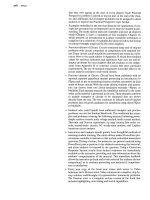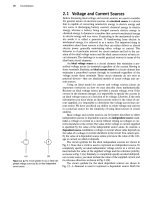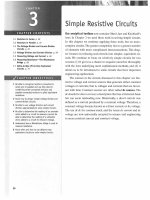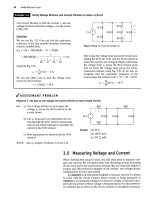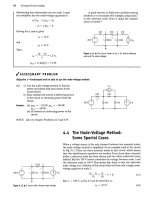Electric Circuits, 9th Edition P74 ppt
Bạn đang xem bản rút gọn của tài liệu. Xem và tải ngay bản đầy đủ của tài liệu tại đây (197.76 KB, 10 trang )
A.2 Cramer's Method
The value of each unknown variable in the set of equations is expressed as
the ratio of two determinants. If we let N, with an appropriate subscript,
represent the numerator determinant and A represent the denominator
determinant, then the /cth unknown x
k
is
N,
Xk =
(A.4)
The denominator determinant A is the same for every unknown variable
and is called the characteristic determinant of the set of equations. The
numerator determinant N
k
varies with each unknown. Equation A.4 is
referred to as Cramer's method for solving simultaneous equations.
A.3 The Characteristic Determinant
Once we have organized the set of simultaneous equations into an
ordered array, as illustrated by Eqs. A.l and A.3, it is a simple matter to
form the characteristic determinant. This determinant is the square array
made up from the coefficients of the unknown variables. For example, the
characteristic determinants of
Eqs.
A.l and A.3 are
A =
21
-3
-8
-9
6
-4
-12
-2
22
(A.5)
and
A =
2
0
7
-1
4
0
0
3
2
(A.6)
respectively.
A.4 The Numerator Determinant
The numerator determinant N
k
is formed from the characteristic determi-
nant by replacing the kth column in the characteristic determinant with
the column of values appearing on the right-hand side of the equations.
For example, the numerator determinants for evaluating /j, /
2
, and
1*3
in
Eqs.
A.l are
A/,
=
-33
50
-9
6
-4
-12
-2
22
(A.7)
N->
=
21 -33 -12
-3 3 -2
-8 50 22
(A.8)
and
N
3
=
21
-3
-8
-9
6
-4
-33
3
50
(A.9)
The numerator determinants for the evaluation of t?j, v
2
, and ?;
3
in
Eqs.
A.3 are
N,
=
4
16
5
-1
4
0
0
3
2
(A.10)
and
A
r
,
2
0
7
4
16
5
0
3
2
7V
3
2
0
7
- 1
4
0
4
16
5
(A.ll)
(A.12)
A.5 The Evaluation of a Determinant
The value of a determinant is found by expanding it in terms of its minors.
The minor of any element in a determinant is the determinant that
remains after the row and column occupied by the element have been
deleted. For example, the minor of the element 6 in Eq. A.7 is
•33 -12
50 22
while the minor of the element 22 in Eq. A.7 is
-33
3
The cofactor of an element is its minor multiplied by the sign-
controlling factor
-l
(/+/)
,
where i and j denote the row and column, respectively, occupied by the
element. Thus the cofactor of the element 6 in Eq. A.7 is
_ j (2+2)
-33 -12
50 22
and the cofactor of the clement 22 is
_l(3+3)
-33 -9
3 6
The cofactor of an element is also referred to as its signed minor.
The sign-controlling factor
—
l
((+y)
will equal +1 or
—1
depending on
whether i + j is an even or odd integer. Thus the algebraic sign of a cofac-
tor alternates between +
1
and
—1
as we move along a row or column. For
a 3 X 3 determinant, the plus and minus signs form the checkerboard pat-
tern illustrated here:
+ +
+
+
- +
A determinant can be expanded along any row or column. Thus the first
step in making an expansion is to select a row i or a column
j.
Once a row
or column has been selected, each element in that row or column is multi-
plied by its signed minor, or cofactor. The value of the determinant is the
sum of these products. As an example, let us evaluate the determinant in
Eq. A.5 by expanding it along its first column. Following the rules just
explained, we write the expansion as
A = 21(1)
-2
22
- 3(-1)
-9 -12
•4 22
-8(1)
•9 -12
6 -2
(A.13)
The 2X2 determinants in Eq. A.13 can also be expanded by minors.
The minor of an element in a 2 x 2 determinant is a single element. It fol-
lows that the expansion reduces to multiplying the upper-left element by
the lower-right element and then subtracting from this product the product
of the lower-left element times the upper-right element. Using this obser-
vation, we evaluate Eq. A.13 to
A = 21(132 -8)+ 3(-198 - 48) - 8(18 + 72)
= 2604 - 738 - 720 = 1146.
(A.14)
Had we elected to expand the determinant along the second row of ele-
ments, we would have written
A = -3(-1)
-12
22
+6(+1)
21
-8
-12
22
-2(-1)
21
-8
-9
-4
= 3(-198 - 48) + 6(462 - 96) + 2(-84 - 72)
-738 + 2196 - 312 = 1146.
(A.15)
The numerical values of the determinants N
u
N
2
, and N
3
given by
Eqs.
A.7,
A.8,
and A.9 are
Ni = 1146,
(A.16)
and
N
2
= 2292,
N
3
= 3438.
(A.17)
(A.18)
It follows from
Eqs.
A.15
through
A.18
that the solutions for i\,
i
2
,
and i
3
in
Eq.
A.l are
H-
T
-1A,
i
2
= -/ = 2A, (A.19)
and
N
3
h = ~T =
3
A.
We leave you to verify that the solutions for v
h
v
2
, and v
3
in
Eqs.
A.3
are
49
Vl
= —= -9.8 V,
v
2
= ^| = -23.6 V,
-5
(A.20)
and
„-^fU
36.8
V.
A.6 Matrices
A system of simultaneous linear equations can also be solved using
matrices. In what follows, we briefly review matrix notation, algebra, and
terminology.
1
A matrix is by definition a rectangular array of elements; thus
A =
#ii
a
n
a
u
(l
2
\ (l
22
&
2
T,
_"ml "-ml "m3
«1»
ttln
(A.21)
is a matrix with m rows and n
columns.
We
describe A as being a matrix of
order m by n, or m X «, where m equals the number of rows and n the
1
An excellent introductory-level text in matrix applications to circuit analysis is Lawrence P.
Huelsman,
Circuits,
Matrices,
and Linear
Vector Spaces
(New
York:
McGraw-Hill, 1963).
number of columns. We always specify the rows first and the columns sec-
ond. The elements of the matrix
—
«
n
, a
12
,
«13,
• •
.—can be real numbers,
complex numbers, or functions. We denote a matrix with a boldface capi-
tal letter.
The array in Eq. A.21 is frequently abbreviated by writing
A [
a
ij\mii
>
where a
tj
is the element in the /th row and theyth column.
If m —
1,
A is called a row matrix, that is,
A « [flu a
n
a
l3
••• a
h!
).
If
/2
=
1,
A is called a column matrix, that is,
(A.22)
(A.23)
«11
«21
A
= a
3l
.
(A.
24)
.
a
m\.
If m = n, A is called a square matrix. For example, if m = n = 3, the
square 3 by 3 matrix is
A = «21 «22 «23 • (A.25)
«11
«21
«31
«12
«22
«32
«13
«23
«33
Also note that we use brackets [] to denote a matrix, whereas we use
vertical lines
11
to denote a determinant. It is important to know the differ-
ence.
A matrix is a rectangular array of elements. A determinant is a func-
tion of a square array of elements. Thus if a matrix A is square, we can
define the determinant of A. For example, if
2 1
6 15
then
detA
30 - 6 = 24.
A,7 Matrix Algebra
The equality, addition, and subtraction of matrices apply only to matrices
of the same order. Two matrices are equal if, and only if, their correspon-
ding elements are equal. In other words, A = B if, and only if, a^ = b,j for
all i and
;*.
For example, the two matrices in Eqs. A.26 and A.27 arc equal
because a
n
=
b
n
,a
u
=
b
12
,a
2
i
= 6
2
i,and«
2
2
=
^22
:
"36
4
-20
16
(A.26)
B =
36 -20
4 16
If A and B are of the same order, then
(A.27)
C = A + B
(A.28)
implies
For example, if
ij ^U ij'
(A.29)
4 -6 10
8 12 -4
(A.30)
and
B
16 10 -30
-20 8 15
(A.31)
then
20 4 -20
-12 20 11
(A.32)
The equation
D = A - B
(A.33)
implies
djj = a
tj
- bjj.
For the matrices in Eqs. A.30 and
A.31,
we would have
(A.34)
D
-12 -16 40
28 4 -19
(A.35)
Matrices of the same order are said to be conformable for addition and
subtraction.
Multiplying a matrix by a scalar k is equivalent to multiplying each
element by the scalar. Thus A = kB if, and only if,
a-
t
;
= kbn. It should be
noted that k may be real or complex. As an example, we will multiply the
matrix D in Eq. A.35 by
5.
The result is
5D
-60 -80 200
140 20 -95
(A.36)
Matrix multiplication can be performed only if the number of
columns in the first matrix is equal to the number of rows in the second
matrix. In other words, the product AB requires the number of columns in
A to equal the number of rows in B.The order of the resulting matrix will
712 The Solution of Linear Simultaneous Equations
be the number of rows in A by the number of columns in B. Thus if
C = AB, where A is of order m X p and B is of order /; x n, then C will
be a matrix of order m X n. When the number of columns in A equals the
number of rows in B, we say A is conformable to B for multiplication.
An element in C is given by the formula
(A.37)
The formula given by Eq. A.37 is easy to use if one remembers that
matrix multiplication is a row-by-column operation. Hence to get the /th,
/th term in C, each element in the /th row of A is multiplied by the corre-
sponding element in the /th column of B, and the resulting products are
summed. The following example illustrates the procedure. We are asked to
find the matrix C when
A =
6 3 2
1 4 6
(A.38)
and
B
~4
0
_1
2~
3
-2_
(A.39)
First we note that C will be a 2 X 2 matrix and that each element in C
will require summing three products.
To find Cj! we multiply the corresponding elements in row
1
of matrix A
with the elements in column 1 of matrix B and then sum the products. We
can visualize this multiplication and summing process by extracting the
corresponding row and column from each matrix and then lining them up
element by element. So to find C
u
we have
Row
1
of A
Column 1 of B
6
4
3
0
2
1
therefore
C
n
= 6 X 4 + 3 x 0 + 2 X 1 = 26.
To find Cp we visualize
Row
1
of A 6
Column 2 of B 2
-2 '
thus
C
12
= 6X2 + 3X3 + 2X (-2) = 17.
For C
2
\ we have
Row 2 of A
Column
1
of B
1
4
4
0
6
1
and
C
2
\ = 1X4 + 4X0 + 6X1 = 10.
Finally, for C
2
2 we have
Row 2 of A 1
from which
Column 2 of B 2
-2 '
C
22
= 1 X 2 + 4 X 3 + 6 X (-2) = 2.
It follows that
AB =
26 17
10 2
(A.40)
In general, matrix multiplication is not commutative, that is,
AB & BA. As an example, consider the product BA for the matrices in
Eqs.
A.38 and
A.39.
The matrix generated by this multiplication is of order
3X3,
and each term in the resulting matrix requires adding two products.
Therefore if D = BA, we have
D =
26
3
4
20
12
-5
20
18
-10
(A.41)
Obviously, C =£ D. We leave you to verify the elements in Eq.
A.41.
Matrix multiplication is associative and distributive. Thus
(AB)C = A(BC),
(A.42)
and
A(B + C) = AB + AC,
(A + B)C = AC + BC.
(A.43)
(A.44)
In
Eqs.
A.42,
A.43,
and A.44, we assume that the matrices are conformable
for addition and multiplication.
We have already noted that matrix multiplication is not commutative.
There are two other properties of multiplication in scalar algebra that do
not carry over to matrix algebra.
First, the matrix product AB = 0 does not imply either A = 0 or
B = 0. (Note: A matrix is equal to zero when all its elements are zero.) For
example, if
A =
1 0
2 0
and B =
'0 0'
4 8
then
AB
"0 0
0 0
Hence the product is
zero,
but neither A nor B is zero.
Second, the matrix equation AB = AC does not imply B = C. For
example, if
A =
1 0
2 0_
B =
V,
U 8.
, and C =
"3 4
.5 6
then
AB = AC =
3 4
6 8
butB 56 C.
The transpose of a matrix is formed by interchanging the rows and
columns. For example, if
A =
1 2 3
4 5 6
7 8 9
, then A
r
=
1 4 7
2 5 8
3 6 9
The transpose of the sum of two matrices is equal to the sum of the
transposes, that is,
T _ AT
(A + B)
y
= A' + B'.
(A.45)
The transpose of the product of two matrices is equal to the product
of the transposes taken in reverse order. In other words,
[AB]
7
'
=
B
T
A
r
.
(A.46)
Equation A.46 can be extended to a product of any number of matri-
ces.
For example,
T _ nTr-TttTAT
[ABCD]'
= D'C'B'A
(A.47)
If A = A
7
, the matrix is said to be symmetric. Only square matrices
can be symmetric.
A.8 Identity, Adjoint, and
Inverse Matrices
An identity matrix is a square matrix where a
(/
= 0 for i
<£
y, and a
i}
= 1
for i =
j.
In other words, all the elements in an identity matrix are zero
except those along the main diagonal, where they are equal to l.Thus
and
1
0
0'
1,
1
0
0
0
1
0
0
0
1
1
0
0
0
0
1
0
0
0
0
1
0
0~
0
0
1_
are all identity matrices. Note that identity matrices are always
square.
We
will use the symbol U for an identity matrix.
The adjoint of
a
matrix A of order n X n is defined as
adjA = [A/zkxa,
(A.48)
where A,
y
is the cofactor of %. (See Section A.5 for the definition of a
cofactor.) It follows from Eq. A.48 that one can think of finding the
adjoint of a square matrix as a two-step process. First construct a matrix
made up of the cofactors of A, and then transpose the matrix of cofactors.
As an example we will find the adjoint of the 3x3 matrix
1
3
1
2
2
1
3
1
5
The cofactors of the elements in A are
A„= 1(10- 1) = 9,
A
12
= -1(15 + 1) = -16,
A
]3
= 1(3 + 2) = 5,
A
21
= -1(10 - 3) = -7,
A
22
= 1(5 + 3) = 8,
A
23
= -1(1 +2) = -3,
A
31
= 1(2 - 6) = -4,
A
32
= -1(1 - 9) = 8,
A
33
= 1(2 - 6) = -4.
The matrix of cofactors is
B
9
-7
-4
-16
S
8
5
-3
-4
It follows that the adjoint of A is
adj A = B
7
=
9
-16
5
-7
8
-3
-4
8
-4
One can check the arithmetic of finding the adjoint of a matrix by
using the theorem
adj A
•
A = det A
•
U. (A.49)
Equation A.49 tells us that the adjoint of A times A equals the determi-
nant of A times the identity matrix, or for our example.
det A = 1(9) + 3(-7) - 1(-4) = -8.



